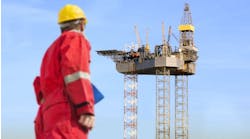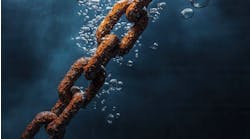How seafloor lift systems establish dual mud gradients
Reducing vessel riser loads
This dual gradient system better matches natural formation pore pressure and fracture pressure gradients, allowing two to three casing strings to be eliminated (compared with a conventional casing program). That in turn leads to greatly reduced deepwater drilling costs, particularly in abnormally pressured areas such as the Gulf of Mexico.
A technical paper (OTC 8751) on this process was presented at the 1998 Offshore Technology Conference by Riley Goldsmith, a contractor to Hydril for the riserless drilling joint industry project. The following is a summary of the paper.
In addition to providing a dual gradient, the system provides fast and simple control of overbalance to improve penetration and bit life, while the doubled hydraulics - in terms of both increased pressure and horsepower - allows high angled holes to be kept clean despite the higher penetration rates.
When the mud lift system, named MudLift, is used with a conventional marine riser, that riser is filled with seawater and the mud is pumped up return lines. When used with independent return lines, the system permits riserless drilling, which cuts the loads on a drilling vessel substantially.
Background
The advantages of a MudLift system increase progressively as water depth increases. However, certain concerns are often raised, relating, for instance, to excess weight of mud in the borehole, pressure limits, and potential for associated well control problems. Answers to these and other queries are discussed below.Firstly, operating procedures for this system are in line with proven techniques currently in use. That includes direct application of subsea pumping, power, measurement, and control technology developed over the past decade or more.
Ordinarily, mud weight for a deepwater dual gradient system need be only a couple of pounds per gallon higher than for a single gradient system. But as the deepwater fracture gradient (and therefore the maximum formation pressures) is limited by the overburden of seawater and formation weight, the maximum mud weight for deepwater drilling turns out to be lower, generally, than for shallow water drilling - typical 16-18 ppg for a dual gradient system.
Subsea pump pressure requirements are also governed by water depth and mud weight, as well as pressure losses in the return lines. In 10,000 ft of water, pump pressure reaches 4,000-5,000 psi. For normal circulation rates, a maximum of 3,000-4,000 horsepower is needed.
For tripping and general drilling tasks, MudLift's subsea diverter system serves primarily to separate drilling returns from seawater. Across the diverter system, pressure differential is basically zero while the MudLift maintains seawater pressure at the sea floor.
When pumps at the surface cease pumping, mud in the drillstring free-falls until pressures "U-tube" to equilibrium. This phenomenon occurs mostly during cementing operations, but can be avoided through use of a specially designed drillstring valve. Under extreme conditions - 10,000 ft water depth and 16 ppg mud weight-U-tubing mud columns can take 20-30 minutes to reach equilibrium. Most of the U-tubing in this case occurs in the first few minutes.
During a connection, the amount of air entering the drillstring has caused some people to voice concern. But in fact, that air volume is basically only as much as the surface volume of gas from cuttings when drilling a gas-bearing formation. So, at most, the added air in the mud stream might increase drillstring corrosion.
Within the MudLift system, a subsea trip tank maintains passively the returning mud pressure equal to the surrounding seawater pressure. This tank is a container comprising two separate chambers for mud and seawater. These are divided typically by a freely floating piston which exerts minimal pressure between the two chambers. The seawater chamber is open to the surrounding seawater.
Mud volume readings provide control set-points, allowing the subsea pump speed to be adjusted to maintain a near-constant trip tank mud level during normal drilling operations. When it is desirable to achieve a return mud wellbore pressure different from the surrounding seawater pressure - or in the event of a kick - the tank can be isolated from the circulating system. Then the return mud pressures provide control set-points for pump speed controls.
During circulation, frictional pressure losses in the drillstring balance the pressure difference between the continuous mud column inside the drillstring and the combined annular mud column and seawater. But when operation of the surface mud pumps stops, the continuous mud column in the drillstring free falls until these hydrostatic pressures equalize and the U-tubing phenomena cease. When 16 ppg mud is used in 10,000 ft of water with 5-in. drill pipe, U-tubing flow volume is around 95 bbl. For 6 5/8-in. pipe operations, a larger trip tank volume is required.
When the drillstring is pulled from the borehole, mud is inserted in the hole to match the volume displaced. That maintains the mud column hydrostatic pressure required to forestall a kick. Mud volume flowing in or out of the borehole is conventionally measured by a trip tank on the drilling vessel (a small volume, storage tank calibrated typically in fractions of a bbl to detect even small variations). MudLift's subsea trip tank operates in a broadly similar fashion, and also provides real time mud measurements for constant, safe monitoring.
Should a kick occur during tripping, the proper wellbore pressure must be maintained at the closed BOP so that neither additional fluid formation influx nor lost circulation occurs. That means bleeding mud from the wellbore in precision quantities to offset the volume of drillstring stripped into the hole, or bleeding mud from the hole to facilitate gas expansion as a gas bubble rises up the hole. In the MudLift's case, volume measurements are performed by the subsea trip tank. When it is almost full with mud bled from the wellbore, that mud is then pumped up the return lines to the surface vessel.
Overbalance control
A key factor impacting drilling rates is the difference between formation pressure and mud column pressure. This overbalance is normally adjusted by altering mud weight, but at deeper drilling depths, formation pressure gradients normally rise, necessitating use of increased mud weight to overbalance the formation pressures.As is well known, high overbalance can cause damage to producing formations, while underbalance or minimal overbalance can improve production rates. However, it is normally impractical to decrease mud density to speed up drilling and then raise density to permit drillstring tripping. Mud system circulation takes several hours and frequent shifts in density are costly and risky, as a miscalculation could lead to a kick.
MudLift, however, permits overbalance changes through temporarily closing the valves to the subsea trip tank and altering the subsea pumping speed according to the boost pressure required to drill with minimal overbalance, increase drilling rates or to decrease formation damage.
While conventional drilling system hydraulics are often inadequate for satisfactory hole cleaning, mud motor operation, and optimum bit performance, MudLift can provide sufficient hydraulic power for these and other operations. The system's hydraulics are typically configured according to maximum circulating pressure, minimum annular velocity for hole cleaning, and maximum available horsepower.
In the MudLift, the maximum circulating pressure is the total of the surface pump pressure limit plus the subsea pump pressure limit - around 8,000-10,000 psi combined with the surface pumps, which is roughly twice as much useable hydraulic power as is commonly available with a conventional drilling system.
Return riser
MudLift can be used with a marine riser. In fact, the prototype will likely be tested to begin with using a conventional seawater-filled riser, but with larger than normal choke and kill lines that function as return risers. The marine riser will also provide guidance for running drilling tools from the drilling vessel to the subsea wellhead.Riser pressure losses of several thousand psi are often suffered during disconnection when drilling with high mud weights in deepwater. But riser loss is avoided with the MudLift because the system uses mud weight high enough to balance formation pressures with only seawater gradient from the sea floor to the surface. Should the need for an emergency disconnect arise, the mud column and the closed BOP provide two independent well control barriers to prevent uncontrolled well flow.
A conventional deepwater circulation system provides little space for increasing wellbore pressure to hinder formation influx while circulating out a kick. Mud column pressure is usually close to the fracture gradient in the open hole section. MudLift can provide a better match between the mud column pressure and fracture gradient, in turn permitting a greater increase in wellbore presure without losing circulation.
A kick can be circulated out by using the constant drillpipe pressure method. While circulating at a constant rate, the subsea trip tank is shut off from the circulating system and back pressure is controlled by adjusting the subsea pump speed to maintain the drillpipe circulating pressure as constant. Readings from a subsea pressure transducer provide real time pressures at the subsea wellbore outlet and BOP stack.
Finally, a dual gradient system is especially desirable for drilling shallow water formations in deepwater, as it permits a higher mud weight to control flow from the shallow formations without exceeding the fracture pressures. In areas where shallow water flows are problematic, weighted mud can be used for drilling with mud returns to the ocean floor. MudLift returns the mud to the vessel for re-use.
Copyright 1998 Oil & Gas Journal. All Rights Reserved.


